Tags
Artists in any culture are a special lot but a chance meeting with Ted Sahl was exceptional.
October 28, 2012
Sunday morning is farmer’s market day in this part of the world and with our grandson in stroller my wife and I were headed towards the Campbell city center for some organic shopping. That’s when I saw this feeble old man arranging a display of paintings outside his house. These were a mix of oils and poster prints, framed and unframed, large and small.
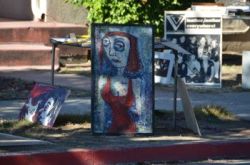
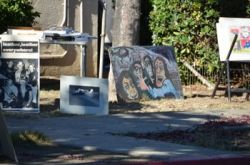
The man was surprised by my interest but pleased—he had just started and wasn’t expecting such an early ‘kill’.
In no time he led us to his garage where he had stacked everything and from where he was bringing out selected pieces.
“Five dollars for any one,” he told us and left.

The garage was a roomful of wonders but our boy was short on patience. Could we come again sometime later? After a deep search through an aged, cracking wallet, he produced his visiting card. “You must add 1 before the number, otherwise it wouldn’t work,” he cautioned the foreigner me.
Oh, wasn’t he a painter? The card said: Ted Sahl, photographer. At home I decided to Google search the man but stopped. Why not discover the fascinating individual rather than have him ‘pre-digested’? For my blog, perhaps?
November 18
I am back in the garage where Ted guides me through in greater detail. That he should be a painter is a trick impression that comes from the size and sizzle of his canvasses. His press accreditation card as a photographer is tucked on the wall right as you enter. Hanging next to which is his very first political cartoon, of Richard Nixon, dated March ’74. Interspersed all over are his photographs, journalistic and otherwise, and in a cupboard all the cameras and gadgetry that shot them. An area partitioned for change of dress etc. that had once been used for fashion photography still stands. Further inside is a section on etchings, along with a stack of ‘negatives’ and the screw-press that pressed them. A painting of a young woman in light translucent shades turns out done with wax sticks—“Put it next to the fireplace and it’s gone,” he laughs. Pieces of metal sculpture lie strewn all over the premises, inside the garage and outside. I didn’t see a book that he may have written but going by the use of language—spoken as well as captions on photographs and otherwise—he might have done that as well.
“This is my entire life’s work,” says Ted with part pride, part regret.
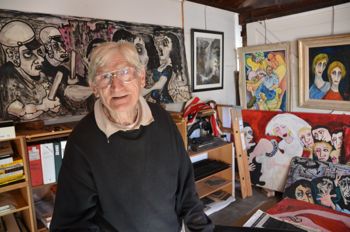
There are sundry collections as well. Masks, terracotta figures, a table lamp with four raised noses surrounding a bland, bare light bulb. “The Nose Lamp! Why not?” he chuckles. Also there is his collection of other people’s work. A bearded middle-aged man appears in many prints on the shelves. He is Ansel Adams, a famous American environmentalist and landscape photographer who worked mostly over the black and white period. Ted is a great admirer and has a number of his photographs on the wall. There is another, highly unusual collection. A friend, falling short on courage to display his erotic work, left his entire folder with him. And died! I saw the folder; also photographed some of it.
For today’s meeting Ted had kept a sofa in the middle of the garage room. (Wonder where he parks! Or if he has anything to park; in which case how does he survive distances?) “What do you have in mind?” he asked as we sat down.
Chance meetings fascinate me, I told him, and I would look to keeping that magic intact in my little piece on him. “I am an outsider,” I said, “and I don’t know how famous or otherwise, loved or hated you are in your state or your country, or even in your neighbourhood, but I see your work around here and I like what I see.”
Ted was pleased.
“I am 85, for whatever it is worth,” he began, “born the day Charles Lindberg landed in Paris, May 21, 1927.” For the uninitiated—I was one—Charles Lindberg is the famous American aviator who made the first solo flight across the Atlantic Ocean. Ted also told me with some pride that as a 5-6 year old, he was spotted by a talent scout from Chicago for admission to their Art School but wasn’t sent. “Good, that way!”
I had prepared a questionnaire of sorts. “In your long years of pursuit of arts Ted, what is it that has kept your kitchen fire burning?” There was a pause. Had I been too blunt, too soon?
“Somebody else asked me this question the other day and I felt it was—degrading.” My heart sank. “I’m an artist, I’m special. I am in the business of dreaming; never made a penny. I’m supposed to be an American, a millionaire, I know.”
I kept the questionnaire aside and decided to go freewheeling.
“I was once doing a film based on a dream, Ted, ” I told him. “And at that time I learnt that men dream in black and white and women in colour. Do you dream in…?”
“I dream in—things; not in color or black and white. I love black and white, I love it. I like coarseness.”
His paintings are representational, his style influenced by Picasso whom he admires—to the point of calling him an American artist. Picasso, American!? “Yes, he built a house in San Francisco,” he gushes and moves on, not wanting to be held to account. And, yes, his paintings are in large parts, and often exclusively, done in black and white. There are portraits, couples, singles. One that he kept returning to was a large canvas depicting a wedding with a number of guests with drooping mouths. “This is my daughter’s marriage and these others are all her boy friends,” he laughed.
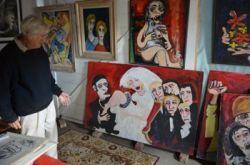
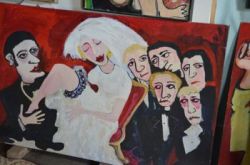
As you dig deeper, you find Ted is passionate about issues. He chanced upon his own brother’s sexual orientation when the man was 60 and was aghast. “So much for the culture of secrecy. And whatever for?” He has since taken up the wider cause of what has come to be known as LGBT—Lesbian, Gay, Bisexual and Transgender—communities. Back in ’78 when he began to reach out to other groups, they first thought he was one among them himself. At which he had a good laugh and told them, “I am sorry, I’m hopelessly heterosexual!” The garage hangs a number of his photographs and posters publicizing gay marches, meets and conferences. There is a large blow up of what appears a female nude but is actually a male dancer.
Most of Ted’s art seems an extension of his photojournalist’s work. And sizable chunk of it portrays specific incidents that he links up with the tenure of one or the other American president. Police action on youth is a running theme of some of his paintings, which surprises me. I didn’t realize the problem might exist at this level in the US—American TV gives no such indication. The two main political parties here, I gather, roughly correspond with our BJP and the Congress in India, Republicans being the local BJP. And soon I see a pattern. If Ted hates a given president, he must be a Republican. Nixon was a this, Reagan that! And he is proud that finally America has a black president.
Which reminded me of a slogan he had displayed on the roof of his house when Obama won his second term. I had driven by that day and couldn’t read what it was.
He threw his hands up in massive regret. “I recycle everything. When I was tearing that, I knew I shouldn’t have been doing that, but—wait a minute…” He got up with a spring not associated with his age and left to go to the main dwelling unit across the yard. He brought back a lot of discarded paper but the slogan was not in it.
“Are you living all by yourself in this house Ted?”
“Well, I have a, woman, if that’s what you mean. No, we never got married; I loved her and she loved me and that seemed enough. But we are moving out.”
“Oh you leaving this house?” I said, wondering if I had misunderstood.
“She is, not me. This is my house, everything paid for.”
Then reverting to the slogan, he sat thinking hard. Too hard for my comfort—I feared he could burst.
“All the money in the world could not buy freedom!” he reproduced in installments. “That’s it. All the money in the world could not buy freedom!”
I didn’t quite understand the context but Ted was obviously high on his formulation.
Returning home I felt satisfied that we had covered a lot of ground. But I was also struck by some omissions. Ted doesn’t have my telephone number, or address; he never asked it. Gullible? Trusting? Senile? Nor, being a photographer, did he show any interest in my fancy camera. Is this perhaps saying that at his age and experience he knows that gadgetry often gets overplayed in discussions on Art? (I guess he feared—though not rightly in my case—that given half a chance I would go on a pixel, gigabyte, megabytes spree! I don’t know the terms from Adam!!)
There was no mention today of asking me to buy any of his stuff either. Quite likely it was because of my changed role but would I be interested if he had? There was no question of my taking any of it to India—its value is purely local I think—but would my children care to put any of it in their house? I wasn’t sure.
December 5
Today I met a very different Ted Sahl—in a deep ‘blue’ mood, so to speak…
[Continued]
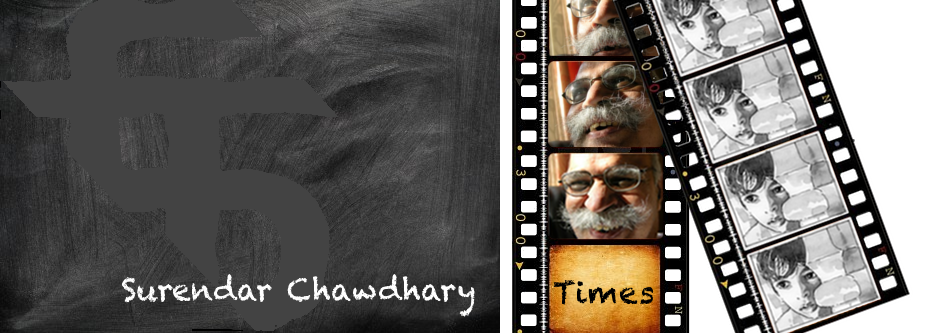
My husband and I are long ago friends of Ted and his woman Lani. In fact, one of the paintings which you show on this blog was done by my husband and given to Ted. The reason I was looking up Ted today is because the Christmas card that I sent to him and Lani had been returned with no forwarding address. We will look to see if he is still living on Campbell Ave. the next time we go into San Jose.
Thanks Louise. Your husband’s is perhaps Ted’s portrait, which is a recognisable likeness from his younger days. I’m in India for the last ten months or so. Do give him my regards in case you meet him before me.
Sorry to tell you. I went by Ted’s house last Saturday and it seemed no one was there. I just got word today that his dementia was so bad that his children had to have him put into a ‘facility’. I’m sorry to see him go like that.
Louise Mitchell
Well, what can one say to a thing like that? Neither here nor there… Thanks Louise, for your effort and letting us know.
Thank you for your article on Ted….I am one of his daughters…..perhaps, you need to talk with ALL his children…..we can give you insight on the real Ted Sahl
On a sheer coincidence I’m in Campbell and am returning to India next week. I’d love to hear from you at +1 (408) 624-6643.
This is my grandpa!
I enjoyed reading your article and the reply.
My grandpa went through a great deal and my Uncle had to take over his estate.
Please keep his amazing art alive.
Thank you
Grace
I just happened upon this article and have read through the responses. I was looking at Ted’s book yesterday, and talking with a friend about how we remember seeing him at so many of the gay events in San Jose back in the 80’s, always wearing that vest full of film and carrying multiple cameras around his neck. Seeing the book was a flashback to a different time, one that young queer people of San Jose today will never know. For me it is a time filled with so many memories both wonderful, celebratory, and then heartbreaking with the arrival AIDS. I don’t know if Ted is still alive upon my writing, since the last comment was from a couple years ago, and it sounds as though he was not well. I am so grateful for his work in documenting the lives, social and political, of queer San Jose culture during the years! Thank You! I recognize that he had many artistic pursuits, and while I am glad he was able to explore so many facets of his creativity, I am most grateful for the photographic work he did within my community.
Ted passed away several years ago. His paintings (including one done of him by my husband) we’re donated to San Jose State University.